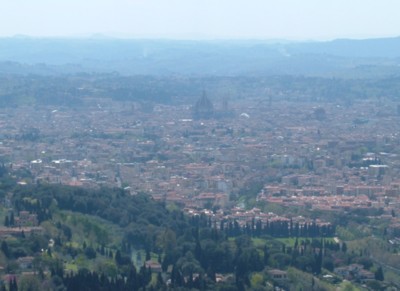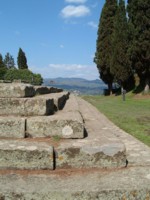Fiesole, perched on a hill overlooking Florence, is a good place to visit to escape the heat and crowds of the town centre.
Fiesole was once Florence’s big brother, but now it’s a sleepy hill-town visited by tourists. Ironically, their main reason for coming here is not to see Fiesole itself, but to admire the view over Florence. Fiesole’s history goes back into the mists of time. As Faesulae, it was an important Etruscan town, commanding the Arno valley from its defensive heights. The Romans encouraged a new settlement, Florentia, on the plain by the river, to drain importance from Fiesole, and gradually Florence became the more important of the two towns. After various spats, the Florentines destroyed Fiesole in the 12th century, since when it has enjoyed quiet, insignificant independence. The local artist Fra Angelico lived and worked in the monastery of San Domenico before descending to San Marco in Florence. Its peace and fresher air made Fiesole a popular resort for rich Florentines who wanted to escape the heat, smells and crowds of the city, and many fine villas were built on the slopes around the town.

From central Florence you can get to Fiesole on the number 7 urban bus. Departing from the railway station, this passes the Duomo and Piazza San Marco before heading out of town and up the hill to Fiesole. The bus drops you in the town square, Piazza Mino da Fiesole. Immediately you can begin to admire the town’s views, and maybe enjoy a drink or snack on the panoramic terrace of the Blue Bar next to the bus stop.
Around the piazza are some of the town’s most important buildings: the Palazzo Vescovile (Bishop’s Palace), originally buit in the 11th century; the town’s cathedral, the Cattedrale San Romolo, constructed and enlarged between the 11th and 14th centuries, which contains some fine frescoes; Palazzo Pretorio, the seat of the town council; and the early Chiesa di Santa Maria Primerana.
Just past the cathedral is the entrance to Fiesole’s attractive archaeological area. Visitors can see the ruins of a Roman theatre, temple and baths, as well as an earlier Etruscan temple dating to the 4th century BC. There are places to sit and admire the view over the Tuscan countryside, and a small cafe. Also on the site is the town’s glossy archaeological museum (Museo archeologico), an imposing modern building built in Roman style which contains exhibits from various phases of Fiesole’s past, from prehistory to the Middle Ages.
The Museo Bandini (Via Dupre 1) contains a selection of local art, mainly dating from the 13th-15th centuries, including some terracottas by the della Robbia family.
One of the very nicest places to sit and enjoy the view is the small Parco della Rimembranza on Via di San Francesco, public gardens with benches, shady trees and a superb panorama. The statue in the park is a 1960s monument to the Carabiniere by the sculptor Marcello Guasti. If you have brought a snack with you, this park is a great place to sit and feast. Further up the hill are two fine churches, the Basilica di Sant’Alessandro and the Chiesa di San Francesco.
There is a Tourist Information Office on Via Portigiani, just past the archaeological area, where you can pick up a map of Fiesole along with information on sights and events. Florence guidebooks generally include pages on Fiesole – the Cadogan guide provides a small town plan and walking itinerary for those who want to explore the town.
Note that Fiesole’s charms are not a well-kept secret. The bus is likely to be packed with other tourists. However, once you start wandering around the town’s lanes, you will soon discover the peace and charm which has brought visitors to the town for hundreds of years.
Fiesole Accommodation
Some Florence visitors, especially in the summer, choose to stay in the cooler air of Fiesole. This is a particularly good option if you have a car.
> Hotels, B&Bs and apartments in and around Fiesole
On this site
Design hotels & chic places to stay
Useful external links
